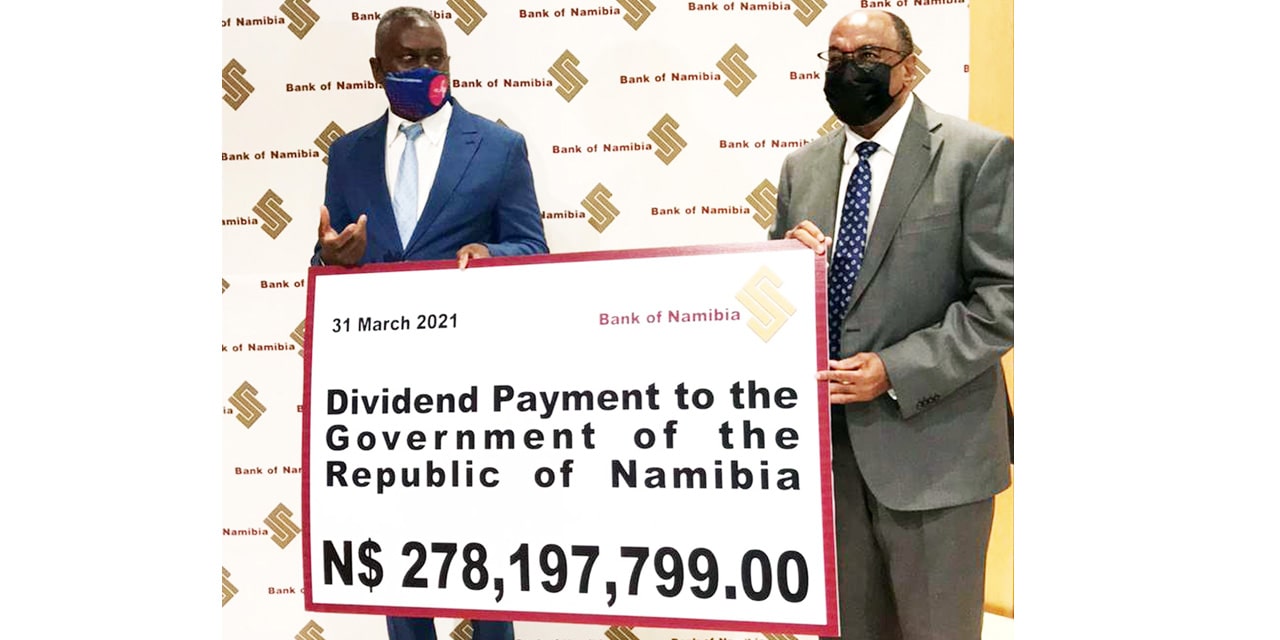Kandjemuni Kamuiiri
The Bank of Namibia on Wednesday declared a N$278.2 million dividend for the 2020 financial year to the State Revenue Fund, lower than the N$399 million declared prior year.
This comes as the apex bank declared a N$532 million surplus for the period under review.
“The financial performance of the Bank in 2020 was negatively impacted by low interest rates in the global markets as a result of the COVID-19 pandemic; nonetheless the Bank still recorded a notable surplus albeit lower in comparison with 2019. As a result of the COVID-19 pandemic, the year 2020 was characterised by a low interest rate environment which resulted in lower interest earned on the Bank’s assets, “Bank of Namibia Governor, Johannes !Gawaxab said.
He said the country’s banking sector remained well capitalised, and thus in a position to withstand potential losses, although asset quality, as measured by the non-performing loan (NPL) ratio, deteriorated rapidly in 2020.
“The banking sector remained resilient and sound during 2020, amidst the low demand for credit and heightened loan defaults as a result of the COVID-19 pandemic. The ratio of NPLs reached an unprecedented level of 6.4 percent of total loans and breached the Bank of Namibia’s crisis benchmark of 6.0 percent from a level of 4.8 percent in 2019. The sector recorded its lowest profitability in ten years; nonetheless the liquidity and capital adequacy of the banking sector remained above the prudential requirements. Although lack of liquidity was expected to become a significant risk due to market uncertainty, the lower demand for credit, coupled with the fiscal stimulus to support the economy ensured that the liquidity position for the banking industry remained strong for most of 2020, “the Governor said.
He said the country’s real GDP is estimated to have contracted by 8.0 percent in 2020, from a milder decline of 0.6 percent in 2019.
“The dismal performance in 2020 was broad-based with the sharpest declines in output recorded in the tourism-related hotels and restaurants and transport sectors, while mining, agriculture, manufacturing, construction, wholesale and retail trade, as well as the public sector also registered negative growth. This was mainly due to the negative effects of the COVID-19 pandemic. However, a better performance was registered in the electricity and water as well as information and communication sectors,” !Gawaxab said.
Going forward, he said the domestic economy is expected to recover in 2021, owing largely to base effects, as well as the anticipated positive growth in key sectors.
“The Namibian economy is expected to record a 2.7 percent growth rate in 2021, as a result of broad-based base effects and better growth prospects for the mining, agriculture, and transport sectors. Downside risks to the outlook include uncertainty around the impact of the COVID-19 pandemic, particularly regarding the tempo and success of vaccinations in Namibia and around the globe. Other risks include travel restrictions that are still in place for many countries, persistently low international prices for some of Namibia’s export commodities, and the possibility of drought in some parts of the country,” !Gawaxab said.
On the fiscal front, he said the overall deficit is estimated to have widened during FY2020/21 as a result of Government’s response to soften the impact of the pandemic on economic activity and a decline in tax revenue.
“The 2020/21 Central Government deficit as a percentage of GDP was estimated at 9.5 percent of GDP for the FY2020/21. When compared to the previous fiscal year, the deficit-to-GDP ratio rose significantly making it the highest deficit ever registered in Namibia. This was attributed to Government’s efforts to reduce the impact of COVID-19 on economic activity and the negative impact of the pandemic on tax revenue. Total Government debt as a percentage of GDP increased to 60.0 percent at the end of December 2020,” the Governor said.




